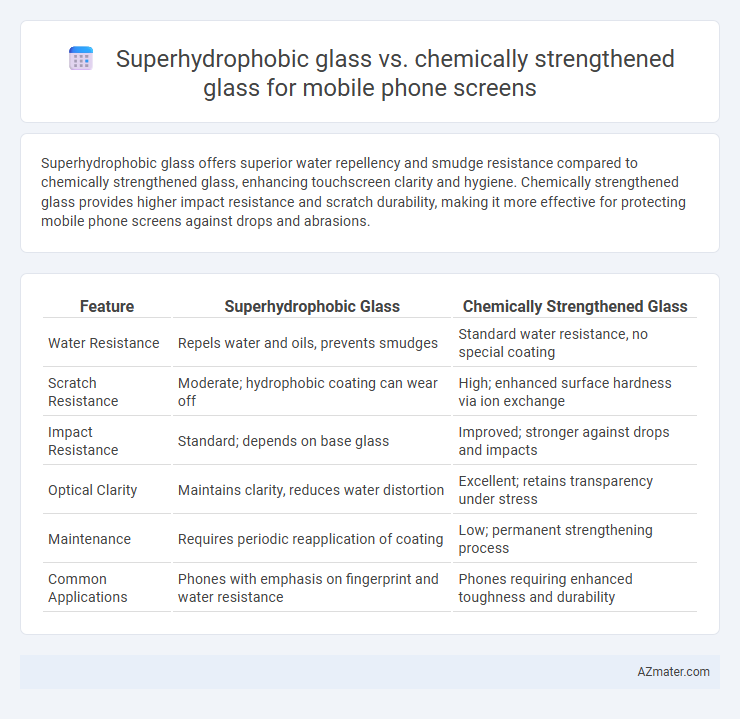Superhydrophobic glass offers superior water repellency and smudge resistance compared to chemically strengthened glass, enhancing touchscreen clarity and hygiene. Chemically strengthened glass provides higher impact resistance and scratch durability, making it more effective for protecting mobile phone screens against drops and abrasions.
Table of Comparison
| Feature | Superhydrophobic Glass | Chemically Strengthened Glass |
|---|---|---|
| Water Resistance | Repels water and oils, prevents smudges | Standard water resistance, no special coating |
| Scratch Resistance | Moderate; hydrophobic coating can wear off | High; enhanced surface hardness via ion exchange |
| Impact Resistance | Standard; depends on base glass | Improved; stronger against drops and impacts |
| Optical Clarity | Maintains clarity, reduces water distortion | Excellent; retains transparency under stress |
| Maintenance | Requires periodic reapplication of coating | Low; permanent strengthening process |
| Common Applications | Phones with emphasis on fingerprint and water resistance | Phones requiring enhanced toughness and durability |
Introduction to Mobile Phone Screen Technologies
Superhydrophobic glass for mobile phone screens features a nano-engineered surface that repels water and reduces fingerprint smudges, enhancing screen clarity and usability under wet conditions. Chemically strengthened glass, such as Gorilla Glass, undergoes ion exchange to increase surface compression, significantly improving scratch resistance and impact durability. Both technologies are integral to mobile displays, with superhydrophobic coatings aiming to improve maintenance and user experience, while chemically strengthened glass ensures structural integrity and longevity.
What is Superhydrophobic Glass?
Superhydrophobic glass is a specially treated surface designed to repel water and reduce fingerprint smudges, enhancing screen clarity and cleanliness for mobile phones. Unlike chemically strengthened glass, which focuses on improving impact and scratch resistance through ion exchange processes, superhydrophobic glass employs nano-coatings to create a water-repellent, self-cleaning effect. This technology enhances user experience by maintaining a pristine screen surface, especially in wet or oily conditions.
What is Chemically Strengthened Glass?
Chemically strengthened glass is a type of toughened glass that undergoes an ion-exchange process, where smaller sodium ions on the glass surface are replaced by larger potassium ions, creating compressive stress to enhance strength and scratch resistance. This treatment significantly improves the glass's durability, making it more resistant to impact and breakage compared to regular glass. Unlike superhydrophobic glass, which primarily repels water and reduces fingerprints, chemically strengthened glass focuses on structural integrity and protection against physical damage for mobile phone screens.
Key Features of Superhydrophobic Glass
Superhydrophobic glass features an ultra-water-repellent surface with a contact angle greater than 150deg, preventing water, oil, and fingerprints from adhering to mobile phone screens. Its self-cleaning property enhances screen clarity and reduces smudge buildup, ensuring better visibility and hygiene. Unlike chemically strengthened glass, which primarily offers scratch and impact resistance through ion exchange processes, superhydrophobic glass emphasizes liquid repellency and surface cleanliness for improved user experience.
Key Benefits of Chemically Strengthened Glass
Chemically strengthened glass for mobile phone screens offers superior scratch resistance and enhanced durability compared to superhydrophobic glass, making it ideal for everyday use and accidental drops. This glass undergoes ion exchange treatment that creates a compressive stress layer, significantly improving its toughness and resistance to cracks. Its excellent impact resistance and long-lasting mechanical strength ensure better protection for touchscreens without compromising clarity or touch sensitivity.
Durability Comparison: Superhydrophobic vs Chemically Strengthened Glass
Superhydrophobic glass offers excellent water and fingerprint repellency but generally lacks the mechanical strength needed to resist scratches and impacts compared to chemically strengthened glass. Chemically strengthened glass, such as Gorilla Glass, undergoes ion-exchange processes that enhance surface compressive stress, significantly improving resistance to cracks and everyday wear. In terms of durability, chemically strengthened glass outperforms superhydrophobic coatings by providing superior impact resistance and scratch durability essential for mobile phone screens.
Scratch and Impact Resistance Analysis
Superhydrophobic glass offers superior water repellency but generally exhibits lower scratch resistance compared to chemically strengthened glass, which undergoes ion exchange processes enhancing surface hardness and durability. Chemically strengthened glass typically provides better impact resistance due to its compressive stress layer, reducing the likelihood of cracks and chips from drops or impacts. While superhydrophobic coatings improve fingerprint and smudge resistance, chemically strengthened glass remains the preferred choice for mobile phone screens requiring high scratch and impact durability.
Water and Oil Repellency Differences
Superhydrophobic glass features a nano-textured surface that creates a high water contact angle above 150deg, making it extremely effective at repelling water and preventing oil adherence through low surface energy coatings. Chemically strengthened glass, such as tempered or aluminosilicate glass, primarily improves mechanical strength and scratch resistance but lacks inherent hydrophobic or oleophobic properties, resulting in lower water and oil repellency. The superhydrophobic treatment provides superior protection against fingerprints, smudges, and liquid damage compared to the standard chemically strengthened glass commonly used in mobile phone screens.
Real-World Applications and User Experience
Superhydrophobic glass offers superior water and oil repellency, significantly reducing smudges, fingerprints, and water damage in daily use, making it ideal for outdoor and wet environments. Chemically strengthened glass, such as Gorilla Glass, provides enhanced scratch resistance and impact durability, crucial for protecting mobile screens from drops and abrasions during everyday handling. Users benefit from the combination of these technologies through clearer visibility, longer screen lifespan, and improved overall device reliability in real-world conditions.
Which Glass Type is Best for Your Mobile Phone?
Superhydrophobic glass offers superior water repellency and fingerprint resistance, enhancing touchscreen clarity and device hygiene. Chemically strengthened glass, such as Gorilla Glass, provides exceptional scratch resistance and impact durability, crucial for protecting against drops and abrasions. For mobile phone users prioritizing durability and everyday protection, chemically strengthened glass remains the best choice, while superhydrophobic coatings serve as valuable complements for cleanliness and usability.

Infographic: Superhydrophobic glass vs Chemically strengthened glass for Mobile phone screen
 azmater.com
azmater.com